Pigeon-eye views of bomb damage in Munich, Occupied Germany - 1948
Feb 16, 2016 13:58:25 #
On the night of April 24/25, 1944, a British Royal Air Force group of 250 Lancaster heavy bombers hit Munich, following the railroad tracks into the main station. They were led to the target by a squadron of twin-engine Mosquitos which had barely enough fuel to make it back to base in England. I took these photos four years later, showing some of the damage remaining in Munich's streets at that time.
A pigeon's eye-view of WW II damage in Munich's center - 1948
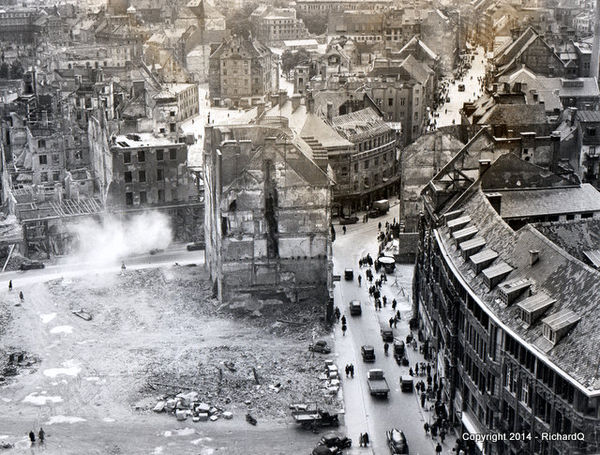
Streetcars passing under Munich's Old City ruins - 1948
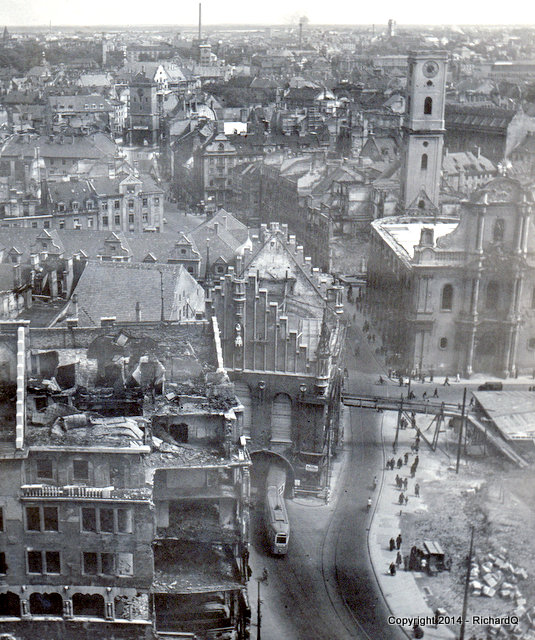
Typical three-car Munich tram in midtown ruins - 1048
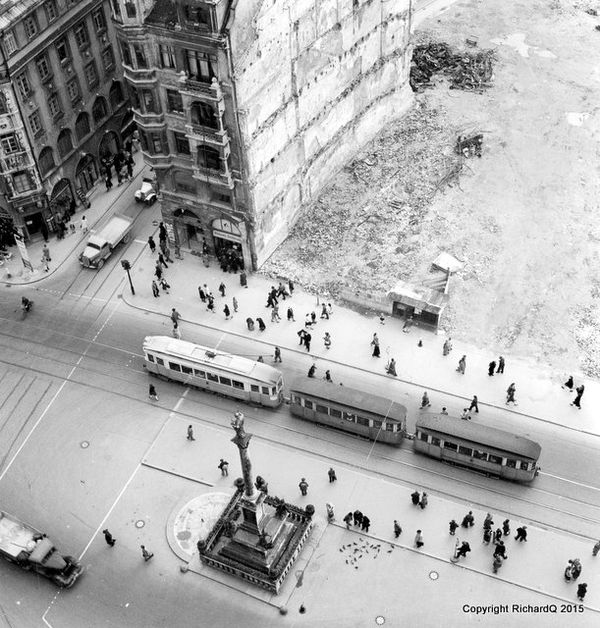
A year after the Nazi surrender, dazed Munich residents view bomb damage next to Isar River
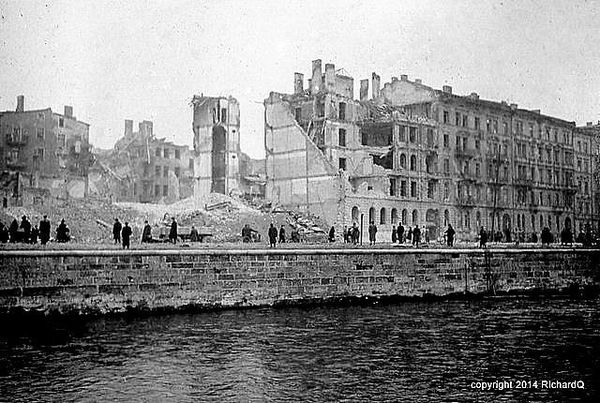
Feb 16, 2016 17:54:18 #
Some of the long-lasting scars of war. Photos like these are needed, lest we forget.
Feb 16, 2016 18:06:36 #
Wonderful Photos! So... did you actually use pigeons to get the aerial shots? Or...?
Feb 16, 2016 21:20:30 #
mallen1330 wrote:
Thank you for the comments, mallen! And especially for the question :D :D ! No, I left the poor Münchener pigeons alone. I doubt I could have found one hefty enough to fly with my Rolleiflex hanging from its neck. I actually climbed up inside the tower of the City Hall which had a balcony near the top. By the way, did you notice that some people were apparently feeding the pigeons near the tram stop?Wonderful Photos! So... did you actually use pigeons to get the aerial shots? Or...?
Feb 17, 2016 00:09:07 #
Nikonian72 wrote:
Thank you for your comments, Douglass. The American public was unaware at the time about the depth of the horror involved in these bombings. Among the worst were Hamburg (1943, ca. 40,000 dead) and Dresden (1945, est. 50,000 to 100,000 +/- dead), caused by firestorms engineered by the heavy bombs and tons of incendiaries dropped in four back-to-back raids. For every ton of bombs dropped on London, the British and Americans dropped 315 tons on Germany.Some of the long-lasting scars of war. Photos like these are needed, lest we forget.
The Hamburg firestorm engulfed an area approximately four miles square, encompassing about 130 miles of street frontage. More than 250,000 homes were destroyed. In some basement air raid shelters crammed with people, there remained only a thin layer of ash. The asphalt on the streets melted into a glutinous stew dotted with corpses of adults and children.
After I returned from the Occupation, one of my elderly aunts timidly asked, "We didn't bomb churches, did we?"
Feb 17, 2016 00:33:32 #
RichardQ wrote:
As a VietNam veteran, I can state with certainty, that no one hates war more than a warrior. We know firsthand the ravages of war.The American public was unaware . . . about the depth of the horror involved in these bombings.
Feb 17, 2016 01:31:45 #
Feb 17, 2016 15:16:19 #
I have to ask if this continuing collection of excellent historic photojournalism, (a very few of which reasonably qualify as traditional street photography) are being submitted as examples of architectural photography? If not acceptable under that heading, Might they not more appropriately be posted to the Gallery?
Feb 17, 2016 17:36:58 #
Uuglypher wrote:
Thank you, Dave, for the compliment. With all due respect, however, I think these photos of people in bombed out cities are more than just "historic photojournalism." If I took those photos of people at street level, I doubt that you would have an issue with the pix. But I took them from a high point because I wanted to stress their resemblance to ants in the eyes of their government. What makes these photos different, IMHO, is the odd and distinct effect of all those "dots" in the streets, which I think is an effect that the traditional street photographers would have embraced. The fact that they are swarming through bombed out ruins adds piquantness to the images. The traditional street photographers wanted to exhibit just that sort of off-base imagery with a bit of social commentary.. . . are being submitted as examples of architectural photography? Might they not more appropriately be posted to the Gallery?
Feb 18, 2016 14:22:48 #
Richard, I very much like the miniture look you achieved in #3. I also like the curious compostion. It ranges from a pristine looking street to a vacant lot with rubble. The people seem to going about as normal, and then there is this big gaping hole in the city. It creates a feeling of tension that makes me want to keep investigating the scene. This one is a gem.
Feb 18, 2016 17:58:00 #
Nightski wrote:
Thank you so much for your comments, Nightski! I was standing in a City Hall tower when I shot these frames, leaning out to get the effect you liked. The Munich citizens had no choice but to work on restoring their lives. When the Nazis surrendered in May 1945, these people were both stunned and relieved, then realized they were prisoners in their own country, hated by their neighboring countries, and governed by their conquerors (many of whom didn't speak German). In the months between May 1945 and May 1946, they were prohibited from writing letters to anybody outside Germany, or even to anybody outside their specific Occupation Zone (Germany was divided into American, British, French and Russian Occupation Zones). Many thousands of men, women and children died of hunger or privation in the bitter winters of 1945/46 and 1946/47. The American soldiers were prohibited from sharing food with Germans or even talking to them for most of the first year of the Occupation.Richard, I very much like the miniature look you achieved in #3. I also like the curious composition. It ranges from a pristine looking street to a vacant lot with rubble. The people seem to going about as normal, and then there is this big gaping hole in the city. It creates a feeling of tension that makes me want to keep investigating the scene. This one is a gem.
Feb 19, 2016 05:19:58 #
RichardQ wrote:
You are right, of course, that the perspective from which the people are included affects my "take" on the difference between "documentary PJ" and "street photography" , but I do understand your view on the matter. It is wonderful that you've been able to preserve this treasure trove of images from those post-war days.Thank you, Dave, for the compliment. With all due ... (show quote)
Feb 19, 2016 16:17:39 #
RichardQ wrote:
Did you share some food anyway? Why were you in a building way up high? The American soldiers were prohibited from sharing food with Germans or even talking to them for most of the first year of the Occupation.
Feb 19, 2016 23:13:43 #
Nightski wrote:
I arrived at Fürstenfeldbruck Air Base in Bavaria in late November, 1945, in bitter cold. Our messhall was a separate building, and we were instructed to bring our field mess kits to use when going through the serving lines. After eating, we left the mess hall and outside were to scrape off any leftovers into garbage bins and then dunk the kit into several hot soapy water barrels and rinse them off. The Germans in the neighboring town were desperate and men, women and children finally began sneaking past the MPs and standing near the barrels, hoping to persuade us to scrape our leftovers into whatever little container they were holding. Some guys went back for seconds and brought that out for them, others gave them their leftovers -- and some told them to go to hell. The Base Provost Marshal soon was ordered to correct the situation because it was a clear breach of security. One afternoon the MPs arrested the begging group and marched them off through the snow to a remote spot, then had them march around in a circle for awhile before sternly warning them never to come back. Meanwhile, the Germans who were employed on the base, and the German Prisoners of War, received one free meal per day, same as us. The European Theater Commanding General contended that it would be impossible for us to feed the Germans. Here's an excerpt from the 1945 information booklet new troops were given. Of course the GIs took candy and small jars of things like Nescafe, etc., off the base, but very few men had the possibility to smuggle out real food. The situation dramatically improved in 1947 when General George C. Marshall became Secretary of State, and the Joint Chiefs of Staff rescinded the draconian mandates of JCS 1067, the orders which governed the American Occupation Zone.Did you share some food anyway? Why were you in a building way up high?
I climbed the stairs inside the Munich City Hall (the Rathaus in German) because I wanted to take the kind of shots I envisoned would be possible.
Excerpt from 1945 Occupation Information brochure
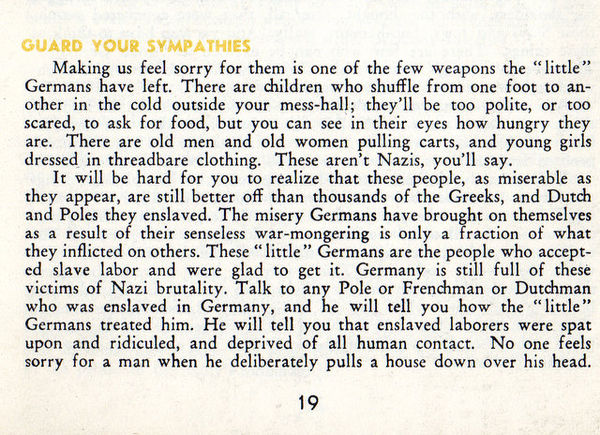
Feb 22, 2016 18:39:40 #
It makes me wonder why the innocent people so often end up suffering for the wrong doing of those in charge. It doesn't sound like these people were the Nazis responsible for murdering thousands.
If you want to reply, then register here. Registration is free and your account is created instantly, so you can post right away.





